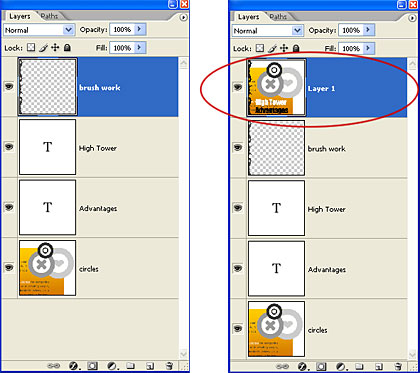Beginners Guide to Adobe Photoshop – Gareth David Tutorials
180 154851 Views 3.99 On 454 Ratings Rate it 1 2 3 4 5

Create a book cover design from scratch
–
Welcome to the complete beginners guide to Adobe Photoshop.
In this series, we will be starting from the very beginning and working our way across 33 episodes to learn all the basics and create a project from scratch
To help break down the process I have structured the course into three main sections:
Section 1 – Introduction
Section 2 – Essential practice
Section 3 – Create a project
Along the way we will be covering many topics, such as how to set up your document, using common tools, creating a project and finally exporting work ready for print and web.
After watching this series you will be able to create your very own artwork in Photoshop ready for print and digital use.
**FYI**
In this video series, I will be using Adobe Photoshop 2016 CC for mac. Almost all of the principles demonstrated and covered will apply to future and previous versions. Some differences may apply if you are using a previous or future version.
Enjoy.
Get the course project files
Access all the files to follow along with the 33 episode course FREE
Download approx 261MB
Download approx 242MB
Need help? Read the download Instructions here.
Get the course interactive PDF index
Tutorial by GD.
Follow for future tutorials & news.
8 Techniques to Help You Start Learning Photoshop
There are many different ways to learn Photoshop from scratch. These simple techniques can help anyone learn Photoshop.

Adobe Photoshop is the doorway to many careers. Graphic design and photography are the most common. Front-end developers and production assistants can also go far with their Photoshop skills. But how do you learn and master Photoshop skills?
The simplest answer is in that old piece of wisdom, "How do you eat an elephant? One bite at a time."
Since everyone has to begin somewhere, let's look at a few ideas to help you learn Photoshop without getting overwhelmed.
1. Learn the Basics of Graphic Design First
It is easy to take graphic design for granted. After all, you hardly notice concepts like alignment, contrast, negative space, and rhythm unless they go wrong. Art school isn't necessary for a graphic designer's job if you roll up your sleeves and go through the grind of mastering the fundamentals of good design.
There are countless free and paid resources to learn the nuances of design. You won't have to buy Photoshop just yet. Instead, begin with the Canva Design School. Also, HackDesign has an excellent newsletter course that will send you one design lesson every week.
Are you in a rush? Then focus on improving your sense of color in under an hour.
2. Get to Know the Photoshop Workspace
Adobe will help you understand the workspace in Photoshop. The Get Started with Photoshop tutorials show you how to utilize the workspace. Open the sample image provided and follow the instructions in the video. Also, learn how to use custom Photoshop workspaces for a faster workflow.
Keep the Workspace basics support page bookmarked if you need to refer to a tool. Also, Photoshop features Rich Tooltips that give you a text description and a video lesson to help you understand each tool's functions. Just hover the mouse pointer over a tool. Alternatively, head to Help > Hands-on Tutorials within the software for interactive learning.
3. Pick One Tool a Day
The palette of Photoshop tools on the left may be narrow and long. Also, click the little arrow under some of them to access the hidden tools. There are nearly 65 tools organized for selection, cropping and slicing, retouching, painting, drawing, and type. So, here's an experiment you can try to familiarize yourself with each of them:
Pick one tool every day. Then, search for a basic tutorial that shows you how it's used in an actual project. For instance, use this clone stamp guide to fix a few practice images.
For instance, a simple query like "tutorial magic wand tool photoshop" will net you many step-by-step lessons on YouTube. The Rich Tooltips in Photoshop are a good starting point too. Use the Search feature within Photoshop to find relevant links.
You won't feel overwhelmed by learning Photoshop one tool at a time. Also, it is an excellent way to memorize the Photoshop keyboard shortcuts right from the onset.
4. Focus on a Photoshop Microskill
Adobe Photoshop is the software photographers must learn to process their images. According to the Adobe Blog:
"Over the past 21 years, Photoshop has meant many different things to many different people. Whether it is used to tell a story, put ideas into motion, imagine something new, visualize science or any of its other many uses."
But did you know that you can even edit videos here? Or create fantastic typography posters? You can even design an email, HTML newsletter, or T-shirt too. Maybe, your boss wants you to design 3D mockups. You have many opportunities to pick up a skill or area you are interested in and get acquainted with Photoshop.
Tip: Photoshop has three core workspaces (Essentials, Photography, Graphic, and Web). But you can create your custom workspace and use that to focus on a microskill.
5. Follow a Photoshop Expert
The easiest way to learn Photoshop is from an expert. A real-world mentor can be difficult to find, but virtual mentors are far easier to get hold of. So first, decide on the area you want to master and search for online experts specializing in that niche.
For instance, find a digital artist who offers digital painting tutorials when you want to learn digital painting.
Adobe's Photoshop experts, such as Julieanne Kost and Terry White can help you get started. You can find them on the Adobe YouTube channel as well. Also, sites like and KelbyOne offer instructor-led courses from the top names in the field.
6. Challenge Yourself With Microjobs
You can start with a rough idea of how to monetize your Photoshop skills for the future. Microjob sites like Fiverr and DesignCrowd can help you earn some money in your spare time. But you may not be ready for a competitive project yet. So, why not use the simpler ones as a testing ground and see if you can meet the challenge head-on.
Assignments are usually simple. For instance, someone may ask you to remove the background from a batch of photos. Or restore a damaged image. Or combine multiple photos into one. This is the "sink or swim" approach to learning Photoshop, but it comes with a degree of responsibility.
Of course, as a beginner, your portfolio may not attract attention. But you have to start somewhere. Alternatively, you can use the skills advertised by others as a template for your education.
Bonus Tip: Seek out virtual volunteering opportunities. Platforms like and Creatives Without Borders can not only help you learn Photoshop skills but also give you valuable alternative work experience.
7. Do a 30-Day Challenge
The duration of the challenge matters less than the habit of learning you put yourself through. A 30-day span is ideal because it is not too long and not too short. Plus, a month is easier to track than a whole year.
If you like structure, then Behance often holds Photoshop creative challenges. Udemy has several free courses and its most popular course on Photoshop will set you back just a few dollars. Ensure your Photoshop version matches the one used in the course.
And if you love YouTube you can try the excellent Photoshop Training Channel. There's no shortage of Photoshop tutorials you can get online with a web search. Just type something like "Photoshop 30-day training challenge" or something similar in the search field.
8. Test Your Limits With Design Prompts
Design prompt generators can test your limits but also make you figure out solutions on your own. Try these graphic design generators for testing your creative muscles:
A Shortcut to Learning Photoshop
Learning the keyboard shortcuts will amp your productivity. But that's the only shortcut Photoshop offers you. There are many different ways to learn the software, but none of them are easy. However, it can be a whole lot of fun if you approach the grind with a goal.
Don't forget the value of deliberate practice. Pick a few tutorials, duplicate them, and then try to modify them with your own creativity. See what the process teaches you.
How to Use Photoshop CS6 ? 5 Best Tips for First Time Users
Home > Adobe Photoshop > How to Use Photoshop CS6 ? 5 Best Tips for First Time Users How to Use Photoshop CS6 ? 5 Best Tips for First Time Users

How to Use Photoshop CS6 ? 5 Best Tips for First Time Users
If you have experience working with Photoshop you will probably have an easy time switching to Photoshop CS6. On the other hand, if this is your first time using Photoshop, you may feel somewhat intimidated. Well, this is perfectly understandable.
How to Use Photoshop CS6 Easily?
The good news is, if you acquire some very basic knowledge of photo edits in CS6 you will likely find that Photoshop is a tool that you will never want to be without. Let’s get started learning the Photoshop CS6 basics for first-time users. In this Photoshop CS6 tutorial for beginners, I’ll cover the following top Photoshop CS6 tools and features that every user must know.
Related:
Editing Images with Photoshop CS6 Camera Raw
Working with the Brush Features in Photoshop CS6
5 Cool Features in Adobe Photoshop CS6
Importing Images for the First Time
Photoshop CS6 is a tool for editing and working with different types of images. Before you begin you must have a few images in mind that you want to work with.
Then, save it in an area on your PC such as My Pictures or another location of your choice. Before you get started, simply click on the arrow icon on the left-hand toolbar.
Click on File on the upper toolbar. Choose Place from the drop-down menu. Browse to the location where your image is stored. Click on the image you want to use. Then, click on the Place option or press the Enter key.
Import images into Photoshop CS6 using File>Place
How to Use Photoshop CS6 to Crop Images?
Although cropping may not seem like an exciting new tool. It is designed to be much easier for the beginner to use in Photoshop CS6.
If you consider the primary editing feature that most people do with their photos. Cropping the image in addition to adjusting the colour and other editing tasks.
The number one thing beginners always want to know is how to do is crop an image.
The Photoshop cropping tool has not really been enhanced in the past until Photoshop CS6. This time it has been improved for usability regardless if you are a beginner or an experienced user.
To get started simply click on the Crop tool on the left-hand toolbar and apply it to the corner of the image. Then, simply drag the handles or you can use the well-known manual crop feature.
Drag the handles in the Crop tool to crop or resize your image
If you want to keep all of your image data prior to cropping, simply remove the checkmark from Delete Crop Pixels to prevent the program from discarding the data until you want to remove it.
To accept the Crop edit you made, simply click on the checkmark on the upper right-hand side. If you want more of the old image back you simply click the Crop tool again on the right-hand toolbar. Use the handles to bring some of the images back.
Photoshop CS6 Basics – Blur Gallery
If you have a photo with multiple activities in the picture and you want to draw attention to more than one aspect. You can use the blur gallery. It contains three features which include the Filled Blur, Iris Blur, and Tilt-Shift.
You can access these settings by clicking on Filter on the upper toolbar. Then, choose Blur from the dropdown menu. These features allow you to do things with an image that you cannot do with a traditional camera.
As an example, if you take the Iris Blur and apply it to the image and then work with the blurring adjustments directly from the interface.
You can reshape the blurred area or dial the blur up or down using the centre of the Iris Blur feature. You can then choose another object in the photo and create the effect again which allows the two effects to be viewed simultaneously. This allows you to enhance the image beyond what you can typically do with a camera.
How to Use Photoshop CS6 Adaptive Wide Angle Feature ?
If you have a photo that you have taken with a wide-angle or fisheye lens, instead of using the lens correction feature you can use the Adaptive Wide Angle feature.
You can access this option by clicking on Filter on the upper toolbar and then choosing Adaptive Wide Angle from the dropdown menu.
The feature automatically identifies the camera and lens that you used so it already knows what adjustments can be made to the photo.
This means that you can straighten aspects of the photo simply by clicking and dragging a line in the area of the photo you want to straighten. It provides a much better custom result than using the Lens Correction feature in past versions.
How to Patch Photo Imperfections in Adobe Photoshop CS6?
In previous versions of Photoshop, if you tried to patch photo imperfections, it would try to sample from the nearest area such as the edge of the photo.
Now, you can patch imperfections using the Content-Aware patch tool. Simply click on the pull-down menu next to Patch on the upper toolbar and choose Content-Aware. Next to Adaptation, choose Very Strict from the drop-down menu. Click on the Patch tool on the left-hand toolbar and outline the imperfection and drag.
Suggested Reads:
How to Organize Photos Using an Album in Photoshop Elements 2019
Importing Photos from a Camera or Card Reader Into Photoshop Elements 2019
How to Crop a Photo and Images in Adobe Photoshop Elements 2019
FAQs
How to use the pen tool in Photoshop CS6? Photoshop CS6 has multiple pen types built inside. You can use each pen type to draw simple to complex shapes. Use the shortcut Shift+P to switch between the various pen types. How to use the clone stamp tool in Photoshop CS6? The clone stamp stool is used to clone parts of an image over another image. Once you have opened an image, click on the clone stamp tool from the tools panel. Select the brush parameters, blend mode, clone mode or opacity, flow rate, alignment types and the layers you want to clone. Now, press Alt+Click on the place where you want to clone. Then, drag your mouse on the part of the image where you want the clone to appear.
Closing Thoughts
These are a few of the key features which will help you get started with using Photoshop CS6.
Once you practice using these options, you can start experimenting with some of the other great tools in CS6 that are available which will help you achieve professional photo results.
If you want to learn more advanced skills, get our Adobe Photoshop CS6 tutorials course online with over 10 hours of videos.
Visit our free Photoshop resource centre for more quality guides and tutorials.







